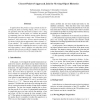Free Online Productivity Tools
i2Speak
i2Symbol
i2OCR
iTex2Img
iWeb2Print
iWeb2Shot
i2Type
iPdf2Split
iPdf2Merge
i2Bopomofo
i2Arabic
i2Style
i2Image
i2PDF
iLatex2Rtf
Sci2ools
154
click to vote
ICDE
2006
IEEE
2006
IEEE
Closest-Point-of-Approach Join for Moving Object Histories
In applications that produce a large amount of data describing the paths of moving objects, there is a need to ask questions about the interaction of objects over a long recorded history. In this paper, we consider the problem of computing joins over massive moving object histories. The particular join that we study is the "Closest-Point-OfApproach" join, which asks: Given a massive moving object history, which objects approached within a distance `d' of one another? We carefully consider several relatively obvious strategies for computing the answer to such a join, and then propose a novel, adaptive join algorithm which naturally alters the way in which it computes the join in response to the characteristics of the underlying data.
| Added | 01 Nov 2009 |
| Updated | 01 Nov 2009 |
| Type | Conference |
| Year | 2006 |
| Where | ICDE |
| Authors | Subramanian Arumugam, Chris Jermaine |
Comments (0)

